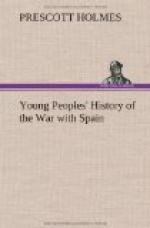Because of the neutrality laws, of which I have told you, after war was declared Dewey’s ships could not stay at Hong Kong more than twenty-four hours, so he moved them to Mirs Bay, a Chinese port, and from there set out to find the Spanish fleet.
A naval officer, now retired from the service, told me not long ago, the words “capture or destroy” have been used in instructions to naval officers for three hundred years. He also spoke of his acquaintance with Dewey during the Civil War, and upon long cruises when they were shipmates; and particularly dwelt upon the ability and good judgment that characterized him as a naval officer.
When Dewey received his orders to “capture or destroy” the Spanish fleet, he is said to have remarked: “Thank the Lord! at last I’ve got the chance, and I’ll wipe them off the Pacific Ocean.” He did not know what he was to meet in the way of resistance, but there was not a man in the fleet that doubted the outcome of the encounter. He found the Spanish fleet, fought it until not a ship was left to fly the flag of Spain, and then sent word to the Spanish Governor-general that if another shot was fired at his ships he would lay the city of Manila in ashes.
[Illustration: Admiral George Dewey.]
The Island of Corregidor guards the entrance to Manila Bay, but it seemed to be asleep as Dewey’s gray ships stole silently by. Once a shell screamed over the Raleigh, followed by another; but the Raleigh, the Concord and the Boston answered the challenge and soon all was silent. At daybreak the fleet was about five miles from Manila, the American flag flying from each ship.
[Illustration: Church of the Friars, Manila.]
Day breaks quickly in the tropics, and as the sun flashed his beams above the horizon, a beautiful picture revealed itself to the men of Dewey’s fleet. Before them lay the metropolis of the Philippines, walled in part like a mediaeval town; the jangle of church bells came from lofty towers. To the right, and below the city, lay the Spanish fleet for which they had been searching.
[Illustration: Dewey on the Bridge.]
The Spaniards fired the first gun from a powerful battery in front of the city, and the Concord sent two shells in reply, as the American fleet swept grandly past. Before them were the Spanish ships-of-war and the fortifications at Cavite; between, were shallow waters where they dared not go. Still they swept on, preserving their distances as though performing evolutions in time of peace, the Olympia in the van, drawing nearer and nearer to the ships that flew the red and yellow flag of Spain. The shore batteries again roared defiance to the invaders, but Dewey stood quietly on the bridge of the Olympia, surrounded by the members of his staff. He wore the usual white uniform of the service, and a gray cap such as travelers and bicyclers wear. A huge jet of water now sprang from the peaceful sea, showing that the Spaniards had fired a submarine mine, but no harm was done. Then Dewey gave the quiet order to Captain Gridley, who was in the conning tower:




